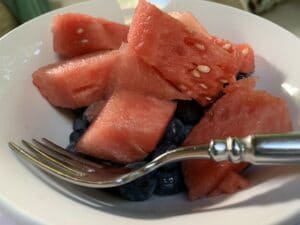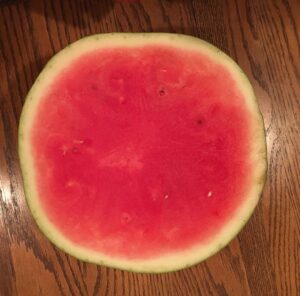Hello fellow readers; Independence Day is a day to celebrate and cherish the freedoms our forefathers fought for and to thank those that serve to protect our freedoms today. Along with the July 4th festivities comes watermelon. Remember the seed-spitting contests? Maybe young uns don’t recall spitting seeds for sport. Hard to do nowadays as most watermelons are said to be seedless, but the truth is, it’s not so – then there’s the oxymoron of seedless watermelon.
 Seedless Watermelons aren’t truly Seedless.
Seedless Watermelons aren’t truly Seedless.
Those little white thingies among the watery pink fruit in seedless watermelons are infertile seeds. Sure, they’re digestible. But so are the traditional black seeds if you’re so inclined. And both won’t cause a watermelon to grow inside your tummy. I still giggle over Mom’s warning, which backfired and inspired me to eat more seeds.
I’ve been on a roll, eating watermelon— not one of my favorite fruits as a kid. Likely due to the mealy castaways we took home after working at the produce stand. We’d bring home corn riddled with worms too. “That means it’s a delicious ear,” Mom would say.
Watermelon is 92% water, hence the name, which helps hydration and is chock full of vitamins such as A and C plus antioxidants like lycopene. They say watermelon may lower blood pressure and cholesterol, have anticancer effects, plus reduce inflammation. And it’s only 46 calories a cup. Sure, a medium wedge contains 17 grams of sugar, but it packs a punch of nutrition, unlike refined sugars and processed foods.
 Seedless Watermelons Relate to Mules.
Seedless Watermelons Relate to Mules.
And seedless watermelons are not genetically modified (GMO). Designing seedless fruit has been in fashion for a long time. Over 2,000 years ago, seedless grapes came from cuttings of adult grape plants rooted in soil. In other words, grape plants aren’t grown from seed but are clones of the mother plant. And while they create seeds, a genetic slipup doesn’t allow them to form fully.
Making seedless watermelon, popular since the ’90s, is a different process. Much like horses mating with donkeys to produce mules, seedless watermelons are hybrids– a mix of two species of animals or varieties of plants. Two mules cannot make more mules as they are sterile. The same is true of seedless watermelons.
The common watermelon (a diploid watermelon) has two sets of chromosomes. Colchicine (pronounced kowl-chuh-seen) from the autumn crocus plant is used on seeds causing the plant to grow four-chromosome flowers. By pollinating a four-chromosome flower with a two-chromosome flower, an infertile watermelon with three chromosomes called a triploid is born.
It sounds fishy—that changing the number of chromosomes isn’t considered genetically altering. But a GMO uses genetic engineering to alter DNA. (DNA stands for deoxyribonucleic acid— the molecule comprising organisms’ genetic code.)
While a chemical from a different plant, the autumn crocus, creates a chromosomal change in the original seed, no genes from other organisms are used to modify a watermelon’s DNA. In other words, scientists didn’t manipulate genes to create seedlessness.
 How do you grow Seedless Watermelon if they don’t have seeds?
How do you grow Seedless Watermelon if they don’t have seeds?
So, how do you grow seedless watermelons if they don’t have seeds you can plant? It sounds like an oxymoron. (I adore that word, which means self-contradictory.)
You’ll need to grow four-chromosome seeds and two-chromosome seeds next to each other so that when they flower, they can cross-pollinate and produce watermelons with three chromosomes making them seedless. Seeds packs come with two kinds of seeds. And yes, you can grow seedless watermelon organically by choosing organic seeds and not using pesticides or chemicals.
I still like to spit watermelon seeds, for old times’ sake. But I’ve outgrown the curiosity of what happens when you eat the seeds. Maturity sometimes changes the magic. Bittersweet (yes, indeedy, another oxymoron).
Garden Dilemmas? AskMaryStone@gmail.com and your favorite Podcast App.
There’s more to the story in the Garden Dilemmas Podcast:
For more on the science of seedless watermelons –
Clemson researcher explains seedless watermelon production
A long-ago story I hope you enjoy: Independence Day on the Top of the World


